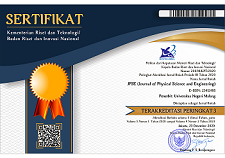Effect of PbS Thin Film Thickness with Cu-Doping on Thermoelectric Properties Using Spin Coating Method
Abstract
A thermoelectric device is produced from several materials that can convert heat into electrical energy or vice versa by generating the Seebeck effect and the Peltier effect. Then the energy can be formed from a heat source. This research used copper monosulfide (CuS) and lead monosulfide (PbS) as the primary materials for thermoelectric manufacture in the form of films. The method used in this research is a spin coating. This method uses the procedure of making a thin film on the substrate. The choice of this material is because CuS and PbS have high electrical conductivity and low thermal conductivity, so the value figure of merit (ZT) is high. From the thin film produced, an annealing process will be carried out to remove unwanted elements. After the sample is finished, the electrical conductivity test will be carried out with four probes, x-ray diffraction (XRD), and scanning electron microscopy (SEM). The four probes' conductivity test characterization results for one-layer, two-layers, and three-layers variations are 27.4 S/m, 53.6 S/m, and 106.8 S/m, respectively. From the SEM results, the grain size obtained from one-layer, two-layers, and three-layers variations are 227.9 nm, 397.8 nm, and 269.6 nm, respectively. Based on the XRD results, the crystal size obtained for variations of one-layer, two-layers, and three-layers has a size of 43.65 nm, 43.55 nm, and 43.60 nm, respectively. Furthermore, the lattice parameter has the same value from each sample variation, which is 5.93 Å.
Keywords
Full Text:
PDFReferences
H. Li et al., “Enhanced thermoelectric performance of carbon nanotubes/polyaniline composites by multiple interface engineering,” ACS Appl. Mater. Interfaces, vol. 13, no. 5, pp. 6650–6658, 2021, doi: 10.1021/acsami.0c20931.
F. H. Lin and C. J. Liu, “Energy‐efficient synthesis and high thermoelectric performance of α‐Cu2−ySe1−xTex,” ChemSusChem., vol. 14, no. 5, pp. 1316–1323, 2021, doi: 10.1002/cssc.202002748.
Y. Luo et al., “Cubic AgMnSbTe3 semiconductor with a high thermoelectric performance,” J. Am. Chem. Soc., vol. 143, no. 34, pp. 13990–13998, 2021, doi: 10.1021/jacs.1c07522.
C. Chang and M. Ibáñez, “Enhanced thermoelectric performance by surface engineering in SnTe-PbS nanocomposites,” Materials, vol. 14, no. 18, p. 5416, 2021, doi: 10.3390/ma14185416.
D. S. Nkemeni, Z. Yang, S. Lou, G. Li, and S. Zhou, “Achievement of extra-high thermoelectric performance in doped copper (I) sulfide,” J. Alloys Compd., vol. 878, p. 160128, 2021, doi: 10.1016/j.jallcom.2021.160128.
Y. Liu et al., “Defect engineering in solution-processed polycrystalline snse leads to high thermoelectric performance,” ACS nano, vol. 16, no. 1, pp. 78–88, 2021, doi: 10.1021/acsnano.1c06720.
J. Pei et al., “Weak-ferromagnetism for room temperature thermoelectric performance enhancement in p-type (Bi,Sb)2Te3,” Mater. Today Phys., vol. 19, p. 100423, 2021, doi: 10.1016/j.mtphys.2021.100423.
J. Wei et al., “Enhanced thermoelectric performance of low carbon cement-based composites by reduced graphene oxide,” Energy Build., vol 250, p. 111279, 2021, doi: 10.1016/j.enbuild.2021.111279.
S. Sarkar et al., “Dissociation of GaSb in n-type PbTe: off-centered Gallium atom and weak electron–phonon coupling provide high thermoelectric performance,” Chem. Mater., vol. 33, no. 5, pp. 1842–1851, 2021, doi: 10.1021/acs.chemmater.0c04854.
T. Y. Su et al., “Thermally strain-induced band gap opening on platinum diselenide-layered films: A promising two-dimensional material with excellent thermoelectric performance,” Chem. Mater., vol. 33, no. 10, pp. 3490–3498, 2021, doi: 10.1021/acs.chemmater.0c04351.
C. Tan et al., “Enhanced thermoelectric performance of p-type sintered BiSbTe-based composites with AgSbTe2 addition,” Ceram. Int., vol. 47, no. 1, pp. 725–731, 2021, doi: 10.1016/j.ceramint.2020.08.182.
S. Yang et al., “Ductile Ag20S7Te3 with excellent shape‐conformability and high thermoelectric performance,” Adv. Mater., vol. 33, no. 10, p. 2007681, 2021, doi: 10.1002/adma.202007681.
H. Zhang, H. Li, and F. Qu, “Synthesis of ZrNiSn with high thermoelectric performance via a novel high-gravity combustion method,” Mater. Lett., vol. 293, p. 129745, 2021, doi: 10.1016/j.matlet.2021.129745.
P. Zhao et al., “Thermoelectric performance of p-type CaxFe1.3Co2.7Sb12 skutterudites from high pressure synthesis,” J. Alloys Compd., vol. 851, p. 156928, 2021, doi: 10.1016/j.jallcom.2020.156928.
Z. Zheng et al., “Rational band engineering and structural manipulations inducing high thermoelectric performance in n-type CoSb3 thin films,” Nano Energy, vol. 81, p. 105683, 2021, doi: 10.1016/j.nanoen.2020.105683.
D. Cadavid et al., “Synthesis, bottom up assembly and thermoelectric properties of Sb-doped PbS nanocrystal building blocks,” Materials, vol. 14, no. 4, p. 853, 2021, doi: 10.3390/ma14040853.
T. Mao et al., “Enhanced thermoelectric performance and service stability of Cu2Se via tailoring chemical compositions at multiple atomic positions,” Adv. Func. Mater., vol. 30, no. 6, p. 1908315, 2020, doi: 10.1002/adfm.201908315.
Q. Jiang et al., “High Thermoelectric performance in n‐type perylene bisimide induced by the soret effect,” Adv. Mater., vol. 32, no. 45, p. 2002752, 2020, doi: 10.1002/adma.202002752.
M. Safavi et al., “Thermoelectric performance of Ge-doped Mg2Si0.35Sn0.65 thin films,” J. Mater. Eng. Perform., vol. 30, no. 6, pp. 4045–4052, 2021, doi: 10.1007/s11665-021-05839-5.
S. Battiston et al., “One step synthesis and sintering of Ni and Zn substituted tetrahedrite as thermoelectric material,” J. Alloys Compd., vol. 702, pp. 75–83, 2017, doi: 10.1016/j.jallcom.2017.01.187.
H. Liu et al., “High-thermoelectric performance of TiO2-x fabricated under high pressure at high temperatures,” J. Materiomics, vol. 3, no. 4, pp. 286–292, 2017, doi: 10.1016/j.jmat.2017.06.002.
U. G. Jong, Y. S. Kim, C. H. Ri, Y. H. Kye, and C. J. Yu, “High thermoelectric performance in the cubic inorganic cesium iodide perovskites CsBI3 (B = Pb, Sn, and Ge) from first-principles,” J. Phys. Chem. C, vol. 125, no. 11, pp. 6013–6019, 2021, doi: 10.1021/acs.jpcc.0c09929.
Copyright (c) 2022 Reza Akbar Pahlevi, Hari Rahmadani, Markus Diantoro

This work is licensed under a Creative Commons Attribution-ShareAlike 4.0 International License.
This work is licensed under a Creative Commons Attribution-ShareAlike 4.0 International License




















